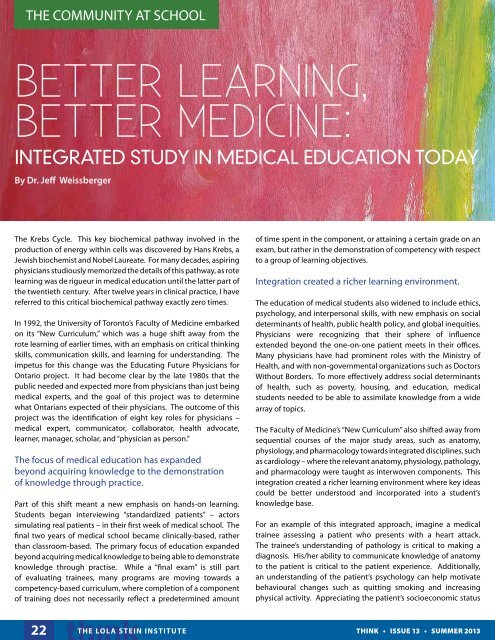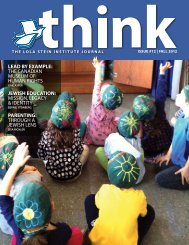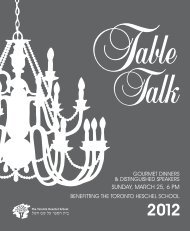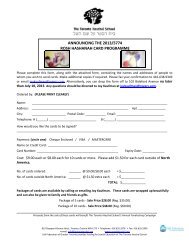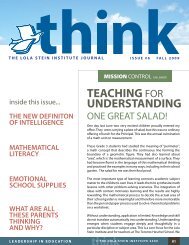Issue No. 13 - The Toronto Heschel School
Issue No. 13 - The Toronto Heschel School
Issue No. 13 - The Toronto Heschel School
Create successful ePaper yourself
Turn your PDF publications into a flip-book with our unique Google optimized e-Paper software.
THE COMMUNITY AT SCHOOL<br />
BETTER LEARNING,<br />
BETTER MEDICINE:<br />
INTEGRATED STUDY IN MEDICAL EDUCATION TODAY<br />
By Dr. Jeff Weissberger<br />
<strong>The</strong> Krebs Cycle. This key biochemical pathway involved in the<br />
production of energy within cells was discovered by Hans Krebs, a<br />
Jewish biochemist and <strong>No</strong>bel Laureate. For many decades, aspiring<br />
physicians studiously memorized the details of this pathway, as rote<br />
learning was de rigueur in medical education until the latter part of<br />
the twentieth century. After twelve years in clinical practice, I have<br />
referred to this critical biochemical pathway exactly zero times.<br />
In 1992, the University of <strong>Toronto</strong>’s Faculty of Medicine embarked<br />
on its “New Curriculum,” which was a huge shift away from the<br />
rote learning of earlier times, with an emphasis on critical thinking<br />
skills, communication skills, and learning for understanding. <strong>The</strong><br />
impetus for this change was the Educating Future Physicians for<br />
Ontario project. It had become clear by the late 1980s that the<br />
public needed and expected more from physicians than just being<br />
medical experts, and the goal of this project was to determine<br />
what Ontarians expected of their physicians. <strong>The</strong> outcome of this<br />
project was the identification of eight key roles for physicians –<br />
medical expert, communicator, collaborator, health advocate,<br />
learner, manager, scholar, and “physician as person.”<br />
<strong>The</strong> focus of medical education has expanded<br />
beyond acquiring knowledge to the demonstration<br />
of knowledge through practice.<br />
Part of this shift meant a new emphasis on hands-on learning.<br />
Students began interviewing “standardized patients” – actors<br />
simulating real patients – in their first week of medical school. <strong>The</strong><br />
final two years of medical school became clinically-based, rather<br />
than classroom-based. <strong>The</strong> primary focus of education expanded<br />
beyond acquiring medical knowledge to being able to demonstrate<br />
knowledge through practise. While a “final exam” is still part<br />
of evaluating trainees, many programs are moving towards a<br />
competency-based curriculum, where completion of a component<br />
of training does not necessarily reflect a predetermined amount<br />
of time spent in the component, or attaining a certain grade on an<br />
exam, but rather in the demonstration of competency with respect<br />
to a group of learning objectives.<br />
Integration created a richer learning environment.<br />
<strong>The</strong> education of medical students also widened to include ethics,<br />
psychology, and interpersonal skills, with new emphasis on social<br />
determinants of health, public health policy, and global inequities.<br />
Physicians were recognizing that their sphere of influence<br />
extended beyond the one-on-one patient meets in their offices.<br />
Many physicians have had prominent roles with the Ministry of<br />
Health, and with non-governmental organizations such as Doctors<br />
Without Borders. To more effectively address social determinants<br />
of health, such as poverty, housing, and education, medical<br />
students needed to be able to assimilate knowledge from a wide<br />
array of topics.<br />
<strong>The</strong> Faculty of Medicine’s “New Curriculum” also shifted away from<br />
sequential courses of the major study areas, such as anatomy,<br />
physiology, and pharmacology towards integrated disciplines, such<br />
as cardiology – where the relevant anatomy, physiology, pathology,<br />
and pharmacology were taught as interwoven components. This<br />
integration created a richer learning environment where key ideas<br />
could be better understood and incorporated into a student’s<br />
knowledge base.<br />
For an example of this integrated approach, imagine a medical<br />
trainee assessing a patient who presents with a heart attack.<br />
<strong>The</strong> trainee’s understanding of pathology is critical to making a<br />
diagnosis. His/her ability to communicate knowledge of anatomy<br />
to the patient is critical to the patient experience. Additionally,<br />
an understanding of the patient’s psychology can help motivate<br />
behavioural changes such as quitting smoking and increasing<br />
physical activity. Appreciating the patient’s socioeconomic status<br />
as a major determinant of health helps the trainee understand how<br />
any limits on the patient’s ability to afford a diet rich in fruits and<br />
vegetables.<br />
<strong>The</strong> vast collection of medical knowledge grows and changes day<br />
by day. <strong>The</strong> complete acquisition of this knowledge is simply an<br />
impossible task. <strong>The</strong> changes in the ways future physicians are now<br />
being educated reflect this fact; they are now taught how to access<br />
current information, how to think critically about this information,<br />
and how to apply and assimilate this knowledge. Many of my<br />
colleagues, just 15 years older than me, went to school before AIDS<br />
had been diagnosed. During the time of my medical education,<br />
AIDS was a universally fatal illness. It is now considered a chronic<br />
disease with many patients living long, fulfilling lives. Only through<br />
ongoing education and assimilation of changing information can<br />
one truly practise medicine effectively.<br />
While these ideas are highly applicable in medical practice,<br />
they really reflect the approach to any profession in the twentyfirst<br />
century. Knowledge is exploding. Access to information is<br />
unprecedented. Success in any field requires a culture of critical<br />
thinking, where one becomes so accustomed to assimilating and<br />
applying new knowledge that this becomes a habit.<br />
<strong>Toronto</strong> <strong>Heschel</strong> mirrors many of the methods for<br />
learning that are used in current medical education.<br />
It is this approach to education that attracted my wife and me<br />
to <strong>The</strong> <strong>Toronto</strong> <strong>Heschel</strong> <strong>School</strong> for our children’s education. <strong>The</strong><br />
school mirrors many of the methods for learning that are used in<br />
current medical education. At <strong>Heschel</strong>, students from Kindergarten<br />
to Grade 8 are immersed in a culture of critical thinking where<br />
integrated experiential learning acclimatizes them to connecting<br />
disparate ideas, demonstrating their understandings and applying<br />
their new knowledge in meaningful ways. Just as today’s medical<br />
students are groomed to become mindful practitioners, <strong>Heschel</strong><br />
students are groomed to develop habits of heart and mind.<br />
<strong>Heschel</strong> students become accustomed to higher-level academic<br />
thinking very early. <strong>The</strong>y feel at home with interdisciplinary<br />
linkages and are comfortable investigating ethical and spiritual<br />
issues within the context of what they are learning in science class,<br />
language arts, or social sciences. For example, <strong>Heschel</strong> children<br />
begin to explore the imperatives of social responsibility and Tikkun<br />
Olam (repair of the world) beginning in Junior Kindergarten and<br />
these concerns remain interwoven into almost everything they<br />
learn until they graduate.<br />
For doctors, integration means better medicine;<br />
for children, it means better learning.<br />
We hope to raise children who feel awe and gratitude towards the<br />
world around them. We want them to strive earnestly for deep<br />
understanding and top-notch skills, to recognize what is wrong and<br />
have the strength to make things right. Integrating these goals into<br />
a school’s culture supports students to start this lifelong journey<br />
with tremendous advantage. For doctors it means better medicine<br />
and for children, better learning.<br />
Dr. Jeff Weissberger is a family physician and supervisor to<br />
medical students and residents. In 2012, he received the Award of<br />
Excellence from the College of Family Physicians of Canada, and<br />
the Teaching Award for Teaching in Clerkship from the Peters-Boyd<br />
Academy of the University of <strong>Toronto</strong>. Jeff and his wife Laya live in<br />
<strong>Toronto</strong> with their children.<br />
22 think • issue <strong>13</strong> • SUMMER 20<strong>13</strong><br />
23


